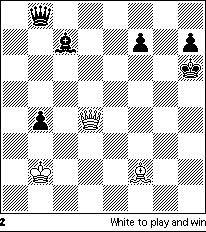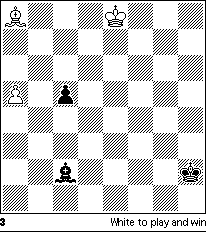
Endgame Explorations 10: Troitzky
Noam Elkies
We now turn to the work of Alexey Alexeyevich Troitzky (1866-1942), who together with Henri Rinck founded the modern art of endgame composition. In The Oxford Companion to Chess we read that Troitzky, educated in Leningrad, was in 1928 named an Honored Art Worker by the Russian government -- "the first time that chess composition was officially regarded as an art form" -- and that, besides his hundreds of studies and extensive endgame analyses, Troitzky also composed problems, often involving retrograde analysis. Troitzky's best known contribution to the game is the analysis of the endgame of two knights against pawn, an endgame which many years later became the first exception to the fifty-move rule recognized by FIDE (since some positions take as long as seventy moves to win, without a capture or pawn move) and recently confirmed by exhaustive computer analysis. Many of Troitzky's studies depend on this analysis, or on his analyses of other endgames where he discovered many new ideas. A common theme in his endgames is a surprising quiet move in a wide-open queen endgame, where one usually assumes that the initiative can only be maintained by continuous checks; a typical case is the following endgame (Bohemia, 1911, reprinted as #24 in his 360 Brilliant and Instructive End Games):

Black barely escapes the direct attack:
1 Qe5+ Kb7
Not 1 ... Ka7 2 Qc7+ Ka6 3 Bd3!
2 Be4+ Kc8 3 Bf5+ Kd8!
3 ... Kb7 loses prosaically: 4 Qb5+ Kc7 (4 ... Kb6 5 Qc5+!\ transposes) 5 Qc5+ Kd8 6 Qf8+ Kc7 7 Qc8+ Kb6 8 Qc5+ Kb7 9 Be4+ Kb8 10 Qb6+ Kc8 11 Bf5+. After 3 ... Kd8!, further checks get White nowhere, but his pieces dominate the board, paralyzing both the king and queen (which must guard against 4 Qd6+ and 5 Bg6#), whence an unusual king march:
4 Kc5! Qd2
Or 4 ... Qc1(g1)+ 5 Kb6(c6) etc.; as in the endgame of two knights against pawn, Black's pawn only hurts him here by preventing such stalemate defenses as 5 ... Qc6(b6)+.
5 Kc6! Qh6+
Or 5 ... Qg2+ 6 Be4 and Black is already helpless against 7 Qc7(d6)+.
6 Kb7
Now Black must also worry about 7 Qc7+ Ke8 8 Bg6+.
6 ... Qh1+
Or 6 ... a4 7 Bd3! with the threat 8 Bb5.
7 Be4 Qh6 8 Bc6 Qh7+ 9 Kb8 Qb1+ 10 Bb5
And White's win can no longer be delayed.
Here are two more classic Troitzky endgames featuring the White queen and
bishop. First, a double cross-pin (L'Echiquier, 1930; #36 in 360 ... End Games):

Again an introductory checking attack:
1 Qf6+ Kh5 2 Qf5+ Kh6 3 Be3+ Kg7 4 Qg5+ Kf8 5 Bc5+ Bd6 6 Qe5!
The first cross-pin; Black dare not take the bishop, exposing his queen, nor
may he play 6 ... Bxe5+ since his own king falls first.
6 ... Kg8
Or 6 ... Qd8 7 Bxd6+ transposing.
7 Bxd6 Qd8
Averting immediate disaster with 8 Qg5+ and 9 Be5+, but now comes an "echo" of the first cross-pin:
8 Qg3+ Kh8 9 Be5+ f6 10 Qg5!
And White wins.
Second, another miniature, this time with subtle introductory play prior to the appearance of the queens (#17 in 360 ... End Games, first published in 28 Rijen):

1 a6 c4 2 a7 c3 3 Bh1!!
A "Bristol clearance": the bishop moves past the "critical square" g2, anticipating Qg2 mate after the mutual promotions.
3 ... Ba4+! 4 Kf7!
White must foresee that the king's control of g6 will be crucial in the coming Q+B vs. Q endgame.
4 ... Bc6!
An "anti-Bristol", dragging the Bh1 back past g2.
5 Bxc6 c2 6 a8/Q c1/Q
So both sides queen, but White still has a decisive attack:
7 Qa2+ Kg3 8 Qg2+ Kf4
Or 8 ... Kh4 9 Qf2+! Kh5(g4) 10 Bf3(d7)+ etc.
9 Qf3+ Kg5
Or 9 ... Ke5 10 Qf6, mate in broad daylight!
10 Qg3+ Kf5 11 Qg6+
At last explaining White's fourth move! Now Black loses the queen after 11 ... Kf4 12 Qh6+ or gets mated with 11 ... Ke5 12 Qf6#.
And finally an early composition (Shakhmatni Zhurnal 1901, #171 of 360 ... End Games), where White wins despite a material deficit:

In his commentary Troitzky engages in some practical retrograde analysis here: "The diagram position could have happened after the actual following play: Re8+, Ka7; RxRf8, h1/Q." The final combination is also of practical value, though its idea occurs more commonly in the middlegame than the endgame.
1 Rb8!
White cannot force the promotion of the f-pawn, but can use the threat of promotion to lure the Black queen to f7.
1 ... Qd5+ 2 Kb2!
To avoid embarrassing checks later. Now 2 ... Kxb8 3 f8/Q+ and 4 Nb3 is a technical win, so the rest is forced.
2 ... Qxf7 3 Rb7+ Ka8 4 Nc6!!
Putting both pieces en prise! Due to the mate threat one of these must be captured, and then the other takes the Black queen (4 ... dxc6 5 Rxf7 or 4 ... Kxb7 5 Nd8+), winning.
Noam Elkies is now Professor of Mathematics at Harvard University and is the author of "Chess Art in the Computer Age," published in ACJ 2 (1993). This article originally appeared in Chess Horizons.Next column: Castling.
This page last modified on
28 April 2018.
Copyright (c) 1995-2018 Christopher F. Chabris. All rights
reserved.




